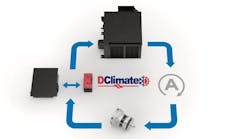Proper management of chargers and batteries crucial to successful deployment
As the industry continues to inch towards implementing electric vehicles (EVs) on a wider scale, one of the large looming questions is how maintenance shops will upskill their workers to meet the complexities and dangers of electric powertrains. While the sample size of fleets incorporating EVs is too small to tell just yet, there are still valuable insights to be gleaned from maintenance shops currently diagnosing and repairing this new technology.
On the maintenance side, the relationship between the EV’s battery and chargers presents the steepest learning curve, as it is most dissimilar to how conventional trucks are fueled. With a diesel truck, you stick the nozzle in, squeeze and lock the handle, and wait until the tank is full. Chargers have the same basic form factor as a fuel pump, with a cord and “nozzle,” but transferring electrons is far more complex. A fleet must consider things like charge cycle, charge volume, rate of speed, and ambient temperature.
According to John Ellis, director of sales, global EV battery solutions at Cox Automotive, understanding and managing battery behavior is the most important aspect of successful EV adoption. By doing so, a fleet ensures vehicles will “continue to have range health through the life of that vehicle so that your long hauls don’t turn into short hauls way too soon.”
That reduction in range over time would likely be due to battery degradation, which Ellis said has “grown exponentially through mismanagement of the battery.” For example, if a fleet has chargers at Florida and Pennsylvania terminals, each will have to be set up to account for the variation in ambient temperature, he advised. Cox has developed an EV Battery Health tool for its Manheim auto resale business that provides health scores for batteries to validate a battery’s health. Cox plans to carry this over to the CEV side as well.
Read more: Electrification impressions: EVs meeting DHL's expectations“In general, battery best practices come down to never fully discharging or overcharging the battery,” explained Nikolas Runge, VP of products and services at InCharge Energy, a developer of commercial electric vehicle charging solutions.
How effectively batteries get charged depends on interoperability, or how the vehicle communicates with the charger, Runge said. He likens the connection to “a handshake” between the two.
An awkward handshake here will interrupt the communication and energy will not flow. This means that a mixed fleet may run into issues as currently “each OEM has a little bit of a different leeway in interpreting” these communication standards, Runge said. One OEM’s set upper or lower tolerances may be considered out of bounds for another and charging could be disrupted.
Runge would like to see more standardization on this front, as has happened with passenger vehicles.
“It was very interesting and actually also astonishing to me that the heavy-duty and medium-duty vehicle OEMs have learned nothing from their passenger vehicle colleagues,” he said.
InCharge offers battery management software and is working on developing a solution using Nikola Tre BEVs. The OEMs also have developed technology to ensure batteries last.
“When it comes to maintaining the battery health the OEMs have built in very smart systems that are keeping the battery at the perfect temperature—they actively cool or warm after delivery prior to charging,” Runge said.
As fleets slowly figure out how to properly operate and charge a few vehicles, they will likely find themselves with vacant chargers and/or underutilized EVs. To make good use of these, InCharge will go into production this August on the V2X bidirectional charger. This allows fleets to generate additional revenue to offset the cost of their EVs by using these vehicles’ batteries for onsite storage.
“For example, a school bus in the summer gets charged when the electricity is cheap, and when the electricity would be too expensive, we can discharge the vehicle,” Runge explained.
This method also can work as an off-grid solution where a row of vehicles can power facilities in case of an outage.
The final piece is getting skilled workers adept at working with high-voltage cables to maintain chargers, which have a slew of wires and controllers that may need service and repair. Having enough people trained in time is a concern to Runge.
“The electrician needs to be specifically trained on that type of charger,” he said. “Otherwise, they cannot repair that.”
It takes about a year for a charger technician to be fully trained and work on their own.





